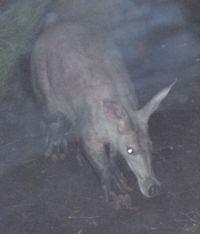Aardvark
2007 Schools Wikipedia Selection. Related subjects: Mammals
| iAardvark | ||||||||||||||
|---|---|---|---|---|---|---|---|---|---|---|---|---|---|---|
 |
||||||||||||||
|
|
||||||||||||||
 Least Concern (LC) |
||||||||||||||
| Scientific classification | ||||||||||||||
|
||||||||||||||
|
|
||||||||||||||
| Orycteropus afer ( Pallas, 1766) |
The Aardvark (Orycteropus afer) is a medium-sized mammal native to Africa. The name comes from the Afrikaans/Dutch for "earth pig" (aarde earth, varken pig), because early settlers from Europe thought it resembled a pig. However, the Aardvark is not closely related to pigs.
Classification
The Aardvark is the only surviving member of the family Orycteropodidae and of the order Tubulidentata. The Aardvark was originally placed in the same order as the South American anteaters because of superficial similarities which, it is now known, are the result of convergent evolution, not common ancestry. For the same reason, Aardvarks bear a striking first-glance resemblance to the marsupial bandicoots, bilbies, and numbats of Australasia, which are not placental mammals at all. The Aardvark is now in its own genus, Orycteropus.
The oldest known Tubulidentata fossils have been found in Kenya and date to the early Miocene. Although the relationships of Tubulidentata are unknown, they are probably ungulates. They spread to Europe and southern Asia during the later Miocene and early Pliocene periods. Two other genera of the family Orycteropodidae are known besides the extant one: Leptorycteropus and Myorycteropus. A genus from Madagascar called Plesiorycteropus may be related to the Aardvark.
In the past, several individual species of Aardvark were named; however, current knowledge indicates that there is only one species, Orycteropus afer, with several subspecies; 18 have been identified but most are regarded as invalid.
Description
The most distinctive charactristic of the Tubulidentata is (as the name implies) their teeth, which, instead of having a pulp cavity, have a number of thin tubes of dentine, each containing pulp and held together by cementum. The teeth have no enamel coating and are worn away and regrow continuously. The Aardvark is born with conventional incisors and canines at the front of the jaw, but these fall out and are not replaced. Adult Aardvarks have only molars at the back of the jaw.
The Aardvark is only vaguely pig-like; the body is stout with an arched back; the limbs are of moderate length. The front feet have lost the pollex (or 'thumb')—resulting in four toes—but the rear feet have all five toes. Each toe bears a large, robust nail which is somewhat flattened and shovel-like, and appears to be intermediate between a claw and a hoof. The ears are disproportionately long, and the tail is very thick at the base and gradually tapers. The greatly elongated head is set on a short, thick neck, and the end of the snout bears a disc, which house the nostrils. The mouth is small and tubular, typical of species that feed on termites. The Aardvark has a long, thin, protrusible tongue and elaborate structures supporting a keen sense of smell.
Weight is typically between 40 and 65 kg; length is usually between 1 and 1.3 m. The Aardvark is a pale yellowish gray in colour, often stained reddish-brown by soil. The coat is thin and the animal's primary protection is its tough skin; the Aardvark has been known to sleep in a recently excavated ant nest, so well does it protect them.
Behaviour
The Aardvark is nocturnal and is a solitary creature that feeds almost exclusively on ants and termites (formicivore); the only fruit eaten by aardvarks is the aardvark cucumber. An Aardvark emerges from its burrow in the late afternoon or shortly after sunset, and forages over a considerable home range, swinging its long nose from side to side to pick up the scent of food. When a concentration of ants or termites is detected, the Aardvark digs into it with its powerful front legs, keeping its long ears upright to listen for predators, and takes up an astonishing number of insects with its long, sticky tongue—as many as 50,000 in one night have been recorded. It is an exceptionally fast digger, but otherwise moves fairly slowly.
Aside from digging out ants and termites, the Aardvark also excavates burrows in which to live: temporary sites are scattered around the home range as refuges, and a main burrow is used for breeding. Main burrows can be deep and extensive, have several entrances and can be as long as 13 meters. The Aardvark changes the layout of its home burrow regularly, and from time to time moves on and makes a new one. Only mothers and young share burrows.
After a gestation period of 7 months, a single cub weighing around 2 kg is born, and is able to leave the burrow to accompany its mother after only two weeks. At six months of age it is able to dig its own burrows, but it will often remain with the mother until the next mating season.
Aardvarks can live to be more than 20 years in captivity.
The aardvark's main predators are lions, leopards, hunting dogs and pythons. Aardvarks can dig fast or run in zigzag fashion to elude enemies, but if all else fails, they will strike with their claws, tail and shoulders, sometimes flipping onto their backs to lash with all fours. Its thick skin also protects it to some extent.
Habitat
The Aardvark is distributed across most of sub-Saharan Africa, and although hunted by humans both for its flesh and for its teeth (which are used as decorations), does not appear to be threatened. The Aardvark has become a staple in the diets of some tribes native to eastern Africa.
